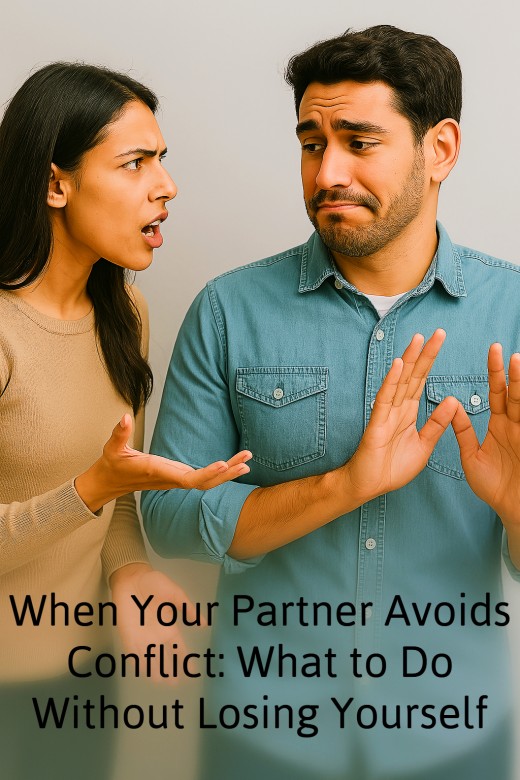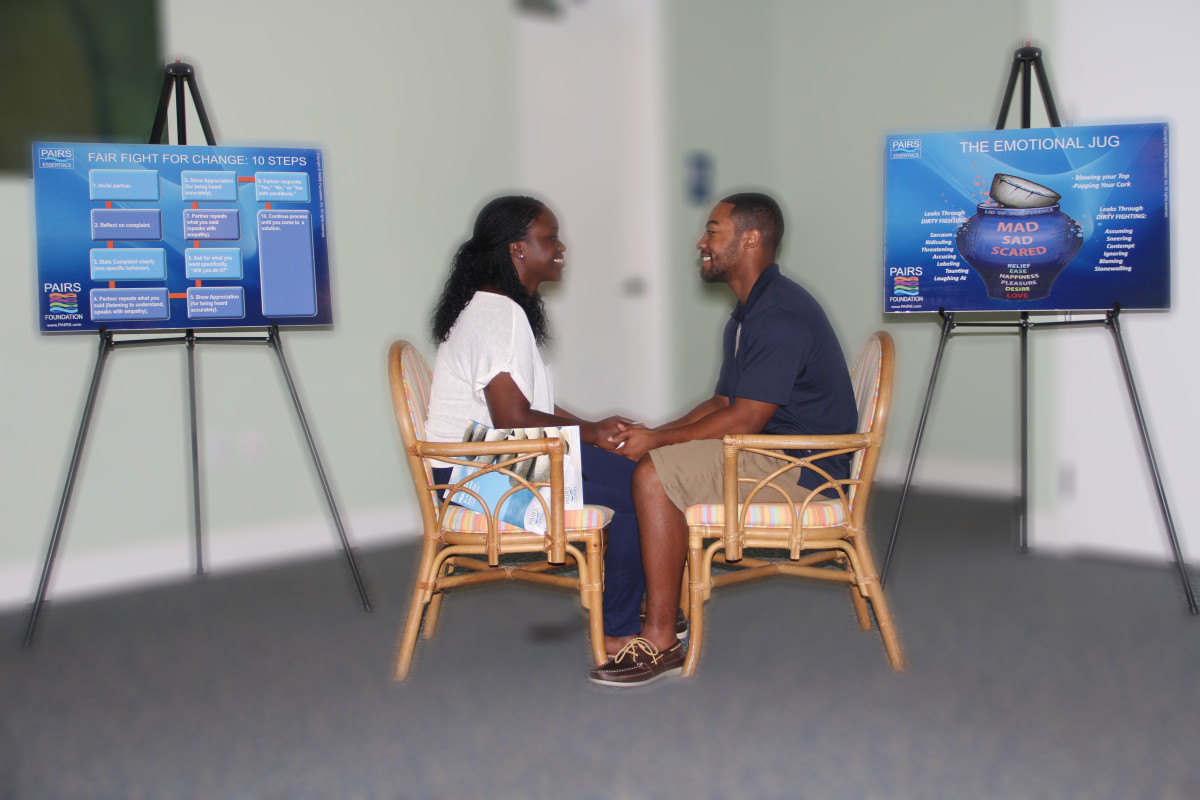How to Communicate With a Conflict Avoidant Partner Without Losing Yourself

Conflict Avoidant Partners: How to Reach Them
Loving someone who avoids conflict can feel like being the only adult in the room. You raise a concern—calmly, clearly, and in good faith—because that’s how healthy relationships grow. But instead of engaging, your partner shuts down. They go quiet. They change the subject. Maybe they act like nothing happened at all.
You’re trying to strengthen the relationship by addressing what’s real, while your partner disappears the moment emotional tension enters the room. And yet, these same partners are often caring, reliable, even affectionate—as long as nothing gets too deep or too charged.
So what’s actually going on beneath their silence? And how do you connect with someone who treats conflict like danger instead of dialogue?
Let’s break it down and explore how to reach a conflict avoidant partner without losing your voice in the process.
Conflict avoidance is a learned coping mechanism where emotional tension feels unsafe—not just uncomfortable—thereby leading partners to withdraw, shut down, or disappear instead of engaging.

What Is Conflict Avoidance, Really?
Conflict avoidance isn’t just about disliking arguments. It’s a deeply ingrained coping strategy. For many, conflict doesn’t just feel uncomfortable—it feels threatening. Maybe they grew up in a home where conflict meant yelling, withdrawal, or instability. Maybe they learned early on that speaking up only made things worse.1
Instead of engaging directly, they might:
-
Shut down mid-conversation
-
Change the subject
-
Say "I don't want to fight" even if no one's raising their voice
-
Nod or agree just to end the discussion
-
Withdraw physically or emotionally
-
Disappear for hours or days without follow-up
This isn't usually manipulation. It's emotional self-protection. Their nervous system may interpret even mild confrontation as danger.2 In some cases, they may not even realize they’re doing it. It’s a learned reflex that kicks in before conscious thought.
Although they might believe they’re keeping the peace, in practice, they’re avoiding the deeper connection that comes from weathering emotional storms together, as a couple.

Why It Hurts to Love Someone Who Avoids Conflict
When you try to discuss a concern and get radio silence, you don’t just lose the chance to resolve the issue. You lose the chance to feel validated.
Conflict can be a gateway to deeper understanding and intimacy. Unfortunately, if one person consistently opts out, it creates a painful imbalance. You’re left managing the emotional dynamics of the relationship on your own—initiating repair, navigating hurt feelings, and doing the work of connection solo.3
Over time, you may therefore begin to:
-
Question whether your needs are even valid
-
Suppress your feelings
-
Walk on eggshells to keep the peace and
-
Resent your partner’s emotional disappearance.
This creates emotional loneliness. You may find yourself mourning the relationship you could have had if you were both able to show up fully. Or you may fantasize about what it would feel like to be met with openness instead of withdrawal.
Even when everything else looks functional—shared chores, steady routine, affectionate gestures—it can feel like something vital is missing. Without mutual vulnerability and emotional presence, love starts to feel like a performance instead of a partnership.

How to Reach a Conflict Avoidant Partner
You can't force someone to be emotionally present. But you can create conditions that help them feel safe enough to stay engaged. Here's how:
1. Pick the Right Moment
Timing matters. Don’t bring up tough topics when your partner is tired, distracted, or already stressed. Instead, say something like, "There’s something I’d like to talk through when we’re both in a good headspace." Alternatively, you might say, "Let me know when you feel up for a deeper conversation."
Framing the conversation in this way gives them a sense of emotional breathing room.4
2. Lead with Curiosity, Not Criticism
Open with questions and observations rather than accusations. For example:
-
"I've noticed you tend to pull back when we hit something uncomfortable. What goes through your mind when that happens?"
-
"I want to understand what feels hard about these conversations for you."
Avoid generalizations like "you always" or "you never." Those are surefire shutdown triggers. Instead, use specific, observable moments: “The other night, when I asked about how we’ve been dividing responsibilities around the house, the conversation stopped. I was hoping we could talk about it.”

3. Regulate Yourself First
If you're visibly frustrated or emotional, a conflict avoidant partner may interpret it as danger. Expressing yourself is important, but doing it calmly helps your partner stay open instead of shutting down.
Use grounding techniques beforehand—deep breathing, pausing before speaking, or writing your thoughts down first. Aim to stay steady so that your partner can stay present and focused.
4. Name the Pattern Without Blame
You might say, "When we hit tough topics and the conversation just stops, I feel really alone. I know it’s not easy, but I want us to get through things together."
This centers your feelings without making them the villain. You’re describing the impact, not diagnosing their flaws. Over time, calling out the pattern gently helps them see the loop they’re caught in.
5. Establish a Repair Ritual
Sometimes, your partner may need space to process. That’s okay—as long as you both agree on how you’ll reconnect.
Ideas:
-
A 30-minute pause followed by a check-in
-
A shared phrase like “Can we circle back?”, “Let’s revisit this again later,” “Can we come back to this?”, or “Let’s take a breather and try again soon.”
-
Writing down thoughts and exchanging notes before talking
-
Setting a recurring time to debrief after disagreements (e.g., "Every Sunday evening, we talk through anything unresolved")
Rituals reduce the unpredictability that keeps them in retreat mode.5 It also shows them that conflict isn’t a rupture—it’s a rhythm that can be repaired.

6. Model Emotional Language
Conflict avoidant people often lack practice identifying and expressing feelings. You can model what emotional literacy looks like:
Instead of saying, "I'm angry," try: "I felt hurt when I didn't hear from you after our disagreement. I really wanted to feel close again."
You’re not just talking about feelings—you’re showing them how to identify and express their own emotions.
7. Know When to Seek Help
If you're doing all the emotional heavy lifting and nothing changes, it might be time to involve a couples therapist. Conflict avoidance that turns into chronic stonewalling or emotional neglect isn’t just frustrating—it’s damaging.
Even if your partner resists therapy, individual support can help you clarify what you're willing (and not willing) to tolerate. It can also help you grieve the relationship you hoped to have, and make choices that support your own peace.

What Not to Do
It’s just as important to avoid these common traps:
-
Don’t pursue or pressure your partner in the heat of the moment
-
Don’t take their avoidance personally
-
Don’t play emotional tug-of-war to get a reaction
-
Don’t stop bringing things up just to keep the peace
Staying silent doesn’t fix avoidance; it reinforces it. The more you suppress your own needs to protect their comfort, the more the relationship becomes emotionally lopsided.

When Conflict Avoidance Becomes a Relationship Dealbreaker
There’s a difference between someone who needs support navigating conflict and someone who refuses to engage, change, or take responsibility for their role in relationship dynamics. If you constantly feel dismissed, unseen, or emotionally alone, it’s okay to re-evaluate your relationship. You deserve a partner who meets you at least part of the way. Someone who won’t bolt when intimacy gets real, someone who can tolerate discomfort in the name of growth.
Change is possible, but only if both people are willing to get uncomfortable. If your partner insists on staying emotionally unavailable, you may have to choose between avoiding conflict with them or finally confronting the conflict within you—the part that knows you need more.

Final Thoughts
Conflict avoidance is rooted in fear, whereas healthy conflict is rooted in care. It’s how couples grow, deepen trust, and stay emotionally aligned. You can offer tools, language, and compassion, but you can’t be the only one doing the work.
If your partner is willing to meet you, even imperfectly, there’s real potential to shift the pattern. However, if they keep disappearing, you may have to ask the hardest question of all: Are you willing to keep showing up for someone who won’t do the same?
Because peace without honesty isn’t peace. It’s the path to resentment. Real connection requires more than avoiding the hard stuff. It asks both of you to show up, speak up, and stay for the long haul.

References
1 BetterHelp. (2023). What is conflict avoidance and how to stop it? https://www.betterhelp.com/advice/conflict/what-is-conflict-avoidance
2 Psych Central. (2023). How to handle conflict avoidance in relationships.https://psychcentral.com/health/how-to-handle-conflict-avoidance
3 Choosing Therapy. (2024). How to communicate with a conflict-avoidant partner.https://www.choosingtherapy.com/conflict-avoidant
4 MindBodyGreen. (2023). Why conflict avoidance happens & what to do about it.https://www.mindbodygreen.com/articles/conflict-avoidance
5 The Gottman Institute. (2022). Understanding stonewalling.https://www.gottman.com/blog/understanding-stonewalling
© 2025 Elaina Baker








